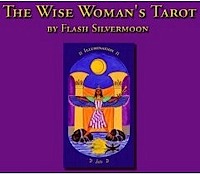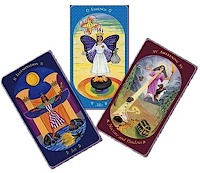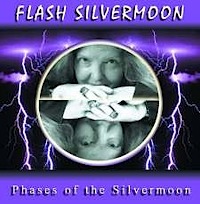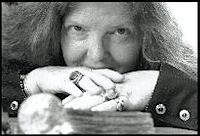By Melanie Harris
Teacher, writer, musician, priestess, and creator of the Wise Woman's Tarot and companion book, Flash Silvermoon is a passionate woman with a bold message. In a divided world fraught with violent aggression, she strives to unite, emphasizing and preserving the multicultural traditions and values of life before patriarchy. In honor of the five year anniversary of The Wise Woman's Tarot, we wanted to speak with Flash to find out what she's up to these days, and to learn more about her intriguing life's work. With new albums and new books forthcoming, Flash graciously made some time in her busy day to chat with us.
Tarot Reflections: Tell me a bit about your latest projects.
Flash Silvermoon: I have a third CD on the way, "Transformations." My music is a mix of rock, blues, funk, and world beat. I'm also working on a book called The Planetary Playbook, which includes astrological visualizations, meditations, and rituals. It will have a companion CD of very ethereal music to help with the visualizations. I have another book on the way, Temple of Isis, that discusses a past life memory. I also have an upcoming book, Lifetime Companion: Love never Dies. It's about my work as an animal communicator, and it deals especially with reincarnation and pets. An excerpt from this book is included in Angel Horses: Divine Messengers of Hope. Some pieces about my work with weather are being included in a book called Rainmaker's Prayers. So, I have a lot of irons in the fire.
TR: I wasn't aware that you're an animal communicator. That's really cool. How long have you been doing that?
FS: I've worked with animals for 25 years. Animals are so much more honest than most people. An animal is just not going to ask, "Hey, what are your credentials?"
TR: (laughs) Well, I know you've also worked with the Tarot for years, 37 years, in fact. The Wise Woman's Tarot is definitely not the work of a novice; the depth of symbolism and mysticism in your deck reflects the depth of your experience. What first inspired you to create The Wise Woman's Tarot and its companion book?
FS: I was teaching with the Tarot, and some of my students at the University told me, "Wow, you have to write a book. The way you teach is so clear and easy to understand. You just have to do it." Originally, I was writing a how-to book on the Rider-Waite, and I had written one page, "Visions for a New Deck," and you know, that one page became a total imperialist and insisted that a whole book be written on it!
TR: I love that your deck includes images of women from many cultures.
FS: That's real important to me. In 1990, I put together a multi-traditional women's spiritual circle, possibly the first of its kind in the Southeast. It was very large. We had an African priestess, a Native American priestess, blended eclectic, Buddhist, Wiccan. We had all these different traditions together; it was great.
I included goddess images from around the world in my deck because I wanted to create a Tarot that was global in scope. I wanted to tell the story, to show the fact, that matriarchy, just like patriarchy, was global. There's a moon goddess in China; there's a Native American moon goddess. It was everywhere.
I began doing my deck thirty years ago, and I don't think there were any other feminist decks on the market at that time. When some feminist decks started coming out, I didn't look too much at those other decks. I didn't want to be influenced. I did take a look at some of them, and most of the decks didn't come close to exploring the magic of the Tarot.
TR: Did you do a lot of research for your deck?
FS: I did research for about fifteen years. It wasn't always every day, but often, I was researching every single day. A lot of other projects had to be put on hold.
TR: Wow. That's a lot of research. I bet you learned some interesting things.
FS: Well, I don't like Crowley at all, but you know, we can learn something from these misogynist types. Look at what they're afraid of, and look at what they try to hide, and there's probably some magic there. Crowley mentions that The Emperor and The Star are out of place, but he doesn't say why they're in the wrong places. I dug deeper, and I found that if you remove The Emperor and put The Star there, you have a Triple Moon Goddess. So, The Emperor replaces Hecate, which is the death principle. So the idea of death being a part of life is replaced with this image of the death-dealing warrior Emperor. That was just the beginning of my knowing where to make some changes in the structure. It winds up, I didn't include The Emperor. I let The Emperor become The Amazon, which shows the masculine within the feminine, before the human race became embodied in two sexes. One could argue, the fact that we're seeing more people at this time choosing not to identify themselves with either sex, is possibly a move back towards that consciousness where sexuality, and even physical bodies, were more fluid. I wanted the whole Major Arcana to be all female, because the Major Arcana represents a time before we're actually embodied into two sexes.
TR: I read a review that criticized your deck as promoting sexism by being too feminist. What is your response to this?
FS: Some people don't do their homework. If you look at the male figures that I include in the court cards, I call the kings Shamans. I wanted to take people out of the Middle Ages. I used pre-patriarchal male images to show options, to show positive male images, positive male roles.
TR: So what patriarchal aspect of other decks bugs you the most?
FS: Well, I've developed a sort of litmus test, to tell if a deck is patriarchal. Look at the Strength card. Look at what they do with it. If it shows some guy in a loincloth swinging a club, then it's patriarchal. If it shows a woman in a peaceful situation with a big cat, it's not. In the Rider-Waite, Pamela Coleman Smith did a good job with this. In the older decks, it's common for the Strength card to show this brute force kind of idea. To me, that's what's wrong with the world.
TR: The Lovers card in The Wise Woman's Tarot is especially interesting in the way it differs from tradition. Can you tell me about it?
FS: The Lovers card shows three women of different density. It shows how we came in and out of body before we came into being in form all the time. It shows our spiritual evolution. And it does show an actual couple there at the bottom of the card. The figures have long hair. It could be a man and a woman, it could be two women, it could be two men…I tried to make it appropriate for all sexual preferences.
TR: Was it hard to find an artist for your deck?
FS: Well, I actually have a degree in art, but I just knew it wasn't my artwork that I wanted to see on the cards. It took four years to find the right artist, Barbara Vogel. I gave her The Lovers card to try, and I told her what I wanted the design to be. I loved what she did. I asked her if she would like to do a few more of them, and she asked if it would be okay if she did the whole deck. I said, "You're on!"
TR: Did you run into any challenges in publishing your deck and book?
FS: (laughs) Everyday! It's not easy to put something like this out. The thing is, there's not a lot of companies willing to take on a Tarot deck. It's very expensive to produce. When the project was in its baby stages, I got a call from a major publisher, and he invited me to meet with him. He said it was some of the best work he'd seen, but that there were too many cultures. He wanted me to change it and make each suit a certain culture, and he wanted to buy all rights. I said, "No, thank you. No, I'm not going to change it, and no, you're not going to own me." Fortunately, a very, very generous and kind friend helped me out, and she became the publisher.
TR: So, what hints can you share with people who hope to create their own Tarot deck?
FS: Make sure that you're sending the deck to a printer who has done cards before. If the printer hasn't printed cards before, take it someplace else. Also, know that it's very hard to make a profit. Distributors take a chunk, and bookstores take a chunk.
And do it right. Take some time. Anyone can make a deck of cards, but not everything can be called the Tarot. Some of these decks that are called Tarot just aren't the Tarot. They're just cards. I don't have a problem with people making decks, but I have a problem with people calling a deck the Tarot when it's not. Before you damage a well-crafted tradition, take some time to learn about it. The Tarot has an ancient heritage that goes way, way back. It was designed to be used around the world, by anyone, where language didn't have to be a barrier. It's just a good code.
TR: Well said! Is there anything else you'd like to share with our readers?
FS: I would love to invite everyone to visit my website, flashsilvermoon.com. Also, I produce The Wise Woman's Festival. We're going into our fifth year. The Wise Woman's Festival is held in the Gainesville, Florida area, April 4-6. It's one of the only festivals of its kind in this part of the country. It's a women's spirituality and cultural festival, and all women are welcome.
TR: This has been a very interesting conversation. I really appreciate you talking with me, Flash.
FS: Well, it's very important that this herstory be preserved.
To learn more about Flash Silvermoon and for more information on her workshops, festivals, The Wise Woman's Tarot, and her other projects, including her debut album, and her second CD, Phases of the Silvermoon, visit her website at http://www.flashsilvermoon.com



